AMD Raven Ridge Gaming Performance Cheat Sheet
AMD's Raven Ridge processors have barreled into the budget gaming market with Zen execution cores paired with the Vega graphics architecture. We've tested the processors from every angle and published a total of 27 pages chronicling our efforts. If you don't have time to sift through all of that, we've condensed all of our gaming results into this single cheat sheet. (For everything else we've written on Raven Ridge, head here.)
AMD's Vega redefines our expectations for integrated graphics, but you still need to keep our hopes in check. The Raven Ridge processors are mostly fit for playing games at entry-level detail settings using lower resolutions than you can unlock with a beefy discrete graphics card.
The flagship Ryzen 5 2400G comes packing four Zen cores with simultaneous multi-threading and 11 CUs, yielding 704 Stream processors. It's priced around $170. AMD positions that model for up to 1080p gaming with reduced graphics detail.
The Ryzen 3 2200G slots in as the extreme budget offering with four physical cores (without SMT) and eight CUs (512 Stream processors) for a mere $100. AMD positions this processor for the esports crowd interested in 720p gaming. Both models have unlocked multipliers, so overclocking is on the menu.
We tested 1080p and 720p gaming with both processors. We also tested 720p gaming with Intel's integrated graphics and AMD's Bristol Ridge, but they aren't up to snuff for most bare-minimum gaming. We paired the Intel processors with discrete graphics cards to make things more interesting, but that increases platform costs dramatically (as listed below). We also include overclocked results for the AMD processors, but be aware that you might need more expensive memory and a better cooler to match our results.
| Platform Cost | Ryzen 5 2400G | Ryzen 3 2200G | Pentium G4620 | Ryzen 3 1300X | Core i5-8400 | Core i3-8100 | Core i3-7100 | AMD A10-9700 |
|---|---|---|---|---|---|---|---|---|
| MSRP | $169 | $99 | $85 | $129 | $187 | $119 | $117 | $99 |
| +GPU | - | - | $89 | $89 | $89 | $89 | $89 | - |
| Total Platform Cost | $169 | $99 | $174 | $218 | $276 | $208 | $206 | $99 |
Keep pricing in mind as you peruse the test results. We have more detailed graphics performance analysis and a breakdown of our test systems in our standalone reviews, but here's the quick story.
Raven Ridge 1080p Gaming



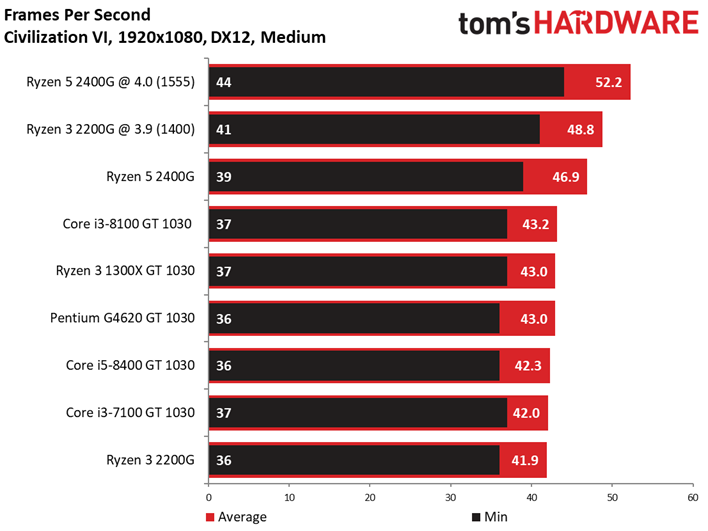
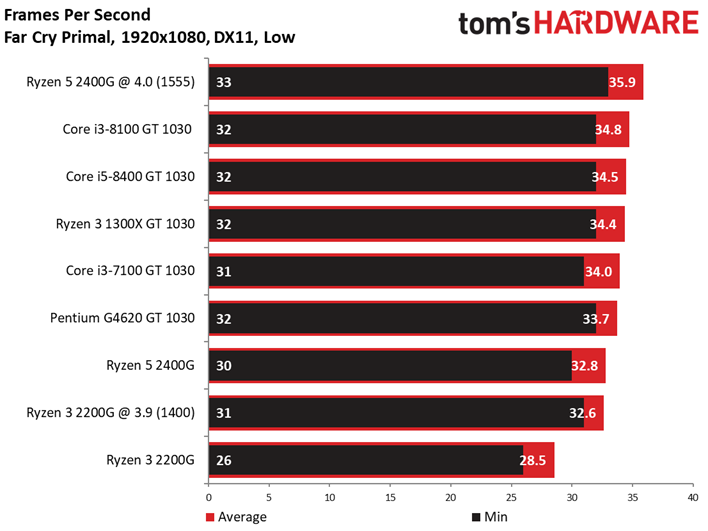
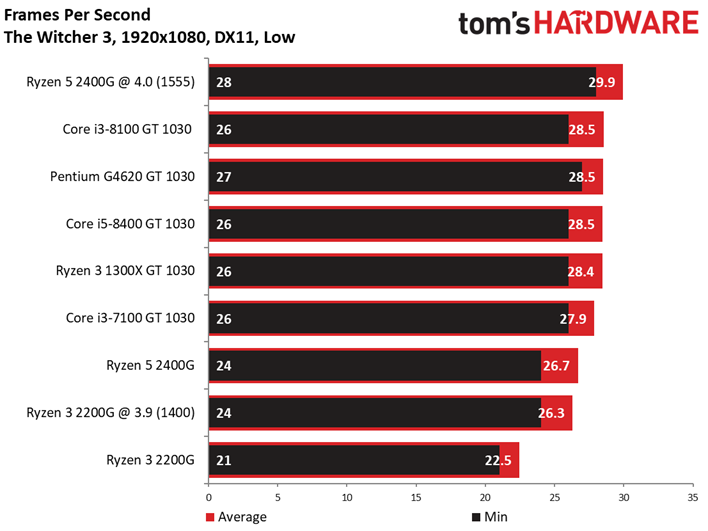




Our 99th percentile FPS chart provides a geometric mean of the 99th percentile results, converted into an FPS measurement, of all the games in our test suite. Those figures represent smoothness and boil the story down rather nicely, although we've also provided the performance results in each game so you can see how the Raven Ridge processors fare in your favorite titles.
Get Tom's Hardware's best news and in-depth reviews, straight to your inbox.
We found that the Ryzen 5 2400G lives up to AMD's claims that it's suitable for 1080p gaming, though your mileage may vary depending on the title. Our Ryzen 5 2400G sample also overclocked easily. With some extra time, we think we could have squeezed even more performance from it.
Speaking of overclocking, a bit of tuning even boosts the Ryzen 3 2200G into contention at 1080p, but don't expect it to happen with a wide range of AAA titles. In either case, any 1080p capability from a $99 processor is fantastic, even if it does come with the added expense of a better cooler and RAM.
Raven Ridge 720p Gaming

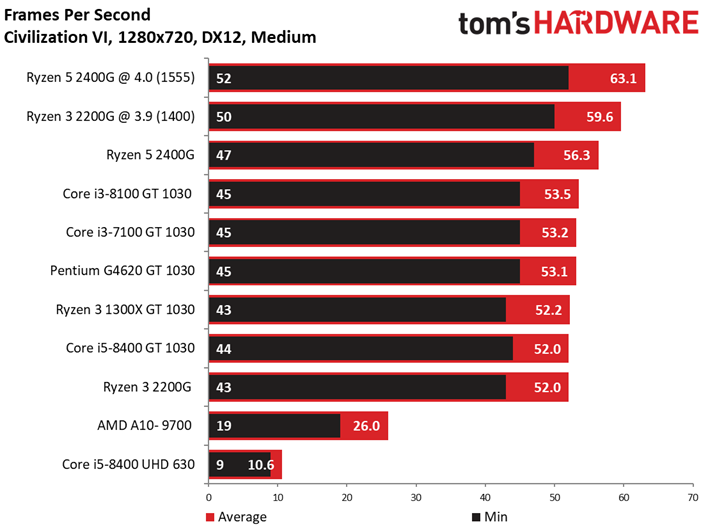


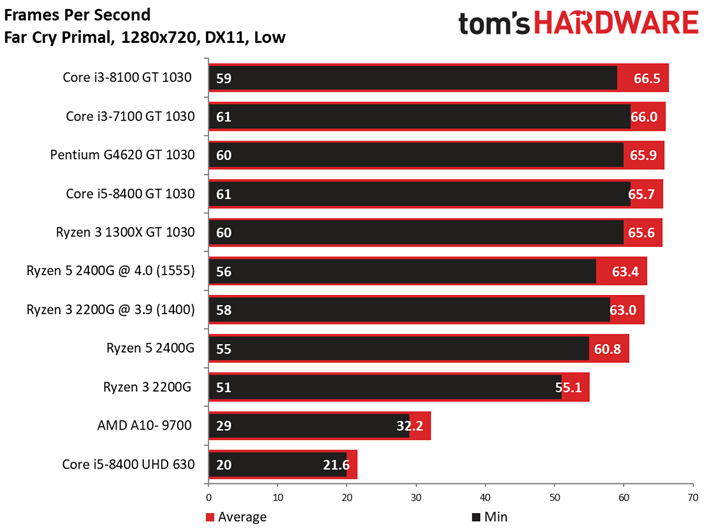
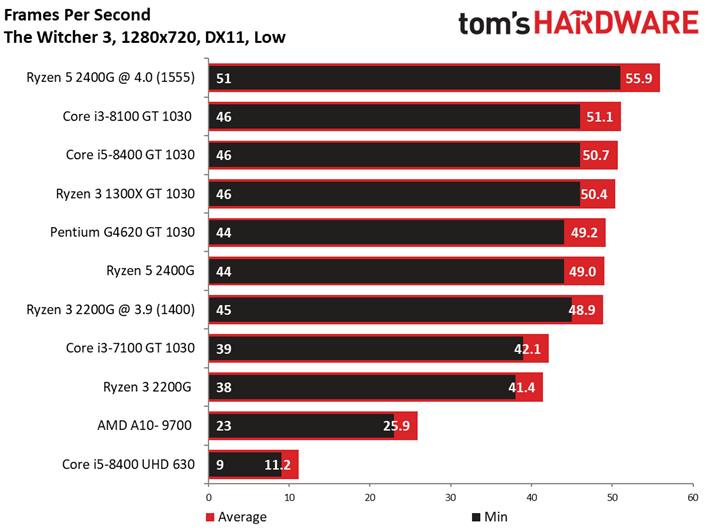
We also find both processors delivering impressive performance in our 720p testing, especially when we factor in pricing for the Intel systems with discrete graphics cards. One look at the Bristol Ridge A10-9700 clarifies how far AMD has come since its last generation of APUs, while Intel's UHD Graphics 630 highlights how far that company needs to go to bring its onboard graphics up to par with AMD's Raven Ridge.
Intel's Pentium lineup finds itself facing serious price-for-performance competition for the first time in years, which is great news for gamers on a tight budget. Memory performance has a big impact on gaming performance with these processors, so you'll need to choose a capable kit. Memory prices are still in the stratosphere, so be sure to plan accordingly.
You'll also need to take steps to make sure that your motherboard has the correct BIOS for the new processors. Existing motherboards need a firmware update to recognize the new models, while newer models include a "Ryzen Desktop 2000 Ready" badge that signals drop-in compatibility. You'll need another AMD processor to update the BIOS, but if you find yourself stranded, AMD has a Boot Kit solution to help out.
Both Raven Ridge models took home our Editor's Choice award. These processors make a great pairing for HTPCs and small form factor desktops. The Ryzen 3 2200G is a great solution for gaming with low-detail settings at 720p, and the Ryzen 5 2400G ups the ante to 1080p gaming at low detail settings with some AAA titles.

Paul Alcorn is the Editor-in-Chief for Tom's Hardware US. He also writes news and reviews on CPUs, storage, and enterprise hardware.
-
derekullo I remember playing wow in college on my Asus EEE an 8 inch netbook with a 900 MHz Intel Celeron M processor at like 15 fps @ 800x600, overclocked of course.Reply
Would have been nice to have this back then.
On the plus side, the EEE did fit into my pocket. -
mr_taitai Nice to compare platforms, but why no platform power consumption graphs? would be interesting to see how many Watt if an apu without discrete would use compared to the processors with the 1030 GTReply -
Co BIY If someone could put out B350 and H270/H370 boards that could use DDR3. I think they could clean up. Whether that's possible memory controller is something I am not qualified to speak to.Reply
Ram costs are out of alignment with processors and motherboards while DDR3 memory speed was not really holding back performance. -
Ncogneto I would like to see a few tests done to show how the raven ridge processors perform against various discreet (low end) graphics cards. At what point do the add in graphics card start to show a performance increase?Reply
For instance, would a similarly clocked, non APU ryzen with an older ATI 7750 out perform the Raven ridge processors? How about an R-390? -
Math Geek i'd like that as well. what exactly is the equivalent discrete gpu for the igp?Reply
i could scan some benchmarks and such but some new data would be nice. would make how a specific cpu/gpu combo compares to the apu in terms of price/performance. what do i get if i spend an extra $30/50/75 for say an i3 and a 1050 or something like that.
just a thought. nice summary article anyway :D -
Co BIY Until Intel releases the the H370, B360 and H310 chipsets the platform cost for Intel Coffee Lake processors needs to include the Z370 chipset premium.Reply
Right now it's like paying a First Class surcharge when you bought a Coach seat. -
larkspur Reply
Just read some 2400g and 2200g reviews. Raven Ridge graphics is very similar to RX 550 and GT 1030. Anything above those GPUs will beat Raven Ridge. Anything below gets beaten by Raven Ridge (including a radeon 7750). GPU Hierarchy chart: http://www.tomshardware.com/reviews/gpu-hierarchy,4388.html20729033 said:I would like to see a few tests done to show how the raven ridge processors perform against various discreet (low end) graphics cards. At what point do the add in graphics card start to show a performance increase?
For instance, would a similarly clocked, non APU ryzen with an older ATI 7750 out perform the Raven ridge processors? How about an R-390?
The CPU-side performance of Raven Ridge is very similar to current Ryzen CPUs with the same core/thread counts and clocks. There are reviews all over the web (including on Tom's) that demonstrate this.
-
larkspur Reply
The integrated memory controller on all Ryzen CPUs does not support DDR3 - they simply didn't design it to include DDR3 support. And on these new powerful Raven Ridge APUs, memory frequency makes a huge difference in graphics performance. Latency might also make a slight difference but the jury is still out on that: https://www.techspot.com/review/1574-amd-ryzen-5-2400g-and-ryzen-3-2200g/page8.html20728887 said:If someone could put out B350 and H270/H370 boards that could use DDR3. I think they could clean up. Whether that's possible memory controller is something I am not qualified to speak to.
Ram costs are out of alignment with processors and motherboards while DDR3 memory speed was not really holding back performance. -
logainofhades Reply20728792 said:I remember playing wow in college on my Asus EEE an 8 inch netbook with a 900 MHz Intel Celeron M processor at like 15 fps @ 800x600, overclocked of course.
Would have been nice to have this back then.
On the plus side, the EEE did fit into my pocket.
I would love to see some current WoW results for these chips.


